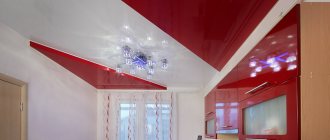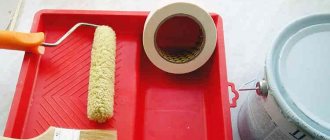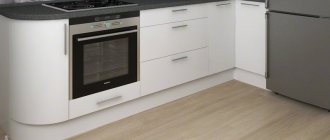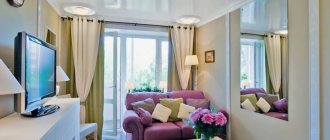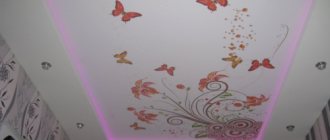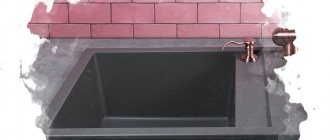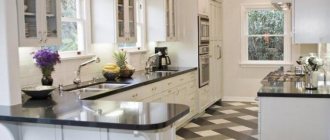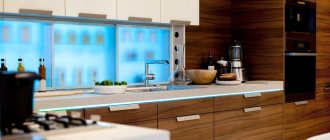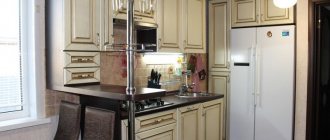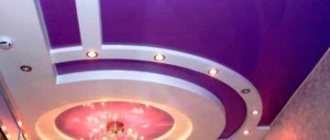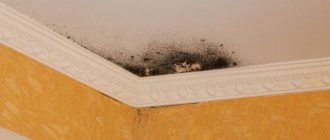The ceiling is the most unused plane in the room, which can easily replace an accent wall and become the highlight of the interior. This is a powerful design tool that will help visually divide a room into functional zones and provide each of them with the necessary lighting.
Why do stretch fabrics compete powerfully with other finishing methods? Let's start with the fact that they are made from different materials, each of which has its own qualities and distinctive appearance.
Advantages and disadvantages of suspended ceilings
The reason for the popularity of these paintings is that they have more pros than cons.
So, the advantages of suspended ceilings in the kitchen include:
- simple (and possibly even cheaper) installation, taking a few hours;
- dust-free repairs, for which you do not always need to remove furniture;
- quick renovation of the interior by changing the canvas;
- moisture resistance and fire safety of the material;
- ease of care;
- absence of condensation, and, accordingly, no reason for the formation of mold and fungi;
- masking ceiling irregularities and communications;
- wealth of colors and textures;
- wide possibilities for lighting design;
- durability (12-15 years).
And most importantly, thanks to their diversity, stretch ceilings will fit into any interior style, as evidenced by these photos.
The disadvantages of suspended ceilings are often associated with low-quality materials or unscrupulous installation.
If we exclude these factors, suspended ceilings in your kitchen may have the following disadvantages:
- the presence of connecting seams when decorating large rooms (width more than 3.2 m);
- loss of 5-10 cm in room height;
- limiting the power of light bulbs built into the ceiling.
All other accusations against suspended ceilings can be called prejudices associated with:
- ignorance of the characteristics and range of uses of polyvinyl chloride, polyester and polyurethane;
- lack of ventilation necessary for the kitchen;
- low-quality fakes with a characteristic pungent odor that does not disappear within a couple of days after installation.
Types of kitchen ceilings
Having decided on the design, you should decide what material will be used to bring the kitchen project to life. The variety of options makes it possible to choose exactly the type of design that suits the style of the kitchen, operating conditions and budget. Below are the types of coatings used on ceilings.
Whitewashing is the cheapest option for covering the ceiling surface and the most popular. This option is classic, does not distract attention and maintains the height of the ceiling.
Whitewashing the ceiling is suitable for rooms with low ceilings.
Keep in mind that such a coating is short-lived; under the influence of external factors, whitewash quickly loses its attractive appearance, and if streaks or stains form, the only solution is to re-coat:
- Painted ceilings are an equally popular option that also requires regular restoration. Light-colored paint tends to acquire a yellow tint; in addition, cracks on a painted ceiling are a common occurrence. The advantages are low price and the ability to do the coloring yourself.
- The decision to install tiles on the ceiling has rather advantages, if we are not talking about foam tiles. The use of this material is unsafe and has long been outdated from a style point of view. Stone or metal-imitating tiles will give the kitchen an ultra-fashionable look; a good solution would be to combine the ceiling with furniture or decorative elements. This coating is practical and safe, but more expensive than paint and whitewash. The high price is compensated by a long service life.
- Covering the ceiling with plasterboard will hide all surface imperfections and provide additional sound insulation. Drywall is used to create suspended ceilings and multi-level structures when choosing this particular ceiling design option in the kitchen. It can be used to hide pipes and wires.
- The use of decorative plaster makes it possible not only to choose the perfect shade, but also to create the desired texture. The coating does not require special conditions of care and operation, and is durable in use.
Painting the ceiling is one of the most famous options.
Be careful, water-based plaster cannot be used on all surfaces:
- If you want to save money, you can use plastic panels. They are easy to clean, resistant to moisture, and in case of possible deformation, it is possible to replace only damaged parts. But it is worth remembering about safety - plastic is flammable.
- Wallpaper, in particular moisture-resistant, is a good solution for the kitchen. The choice of patterns and colors is large; you can choose wallpaper to suit any project. The disadvantage is its fragility, since under the influence of high temperatures, detachments occur at the joints and corners, but they can be eliminated independently using glue.
- Armstrong ceilings are a variant of suspended ceilings; they are rarely used in the kitchen, as they are afraid of moisture, can collapse when dried out from high temperatures, and are not durable - such a ceiling will not withstand a shot of a champagne cork.
- Stretch ceilings are a real leader among coatings. The advantages of this material include durability, a variety of available designs, and the ability to arrange the lighting system in a convenient way. PVC film allows you to decorate the ceilings in the kitchen with a photo or design, and will also save you from flooding by neighbors above by holding back moisture. Doubts are raised about the environmental safety of the material and the installation method - the film, like the entire room, is heated to high temperatures.
- Slatted ceilings involve the use of not only plastic, but also metals: aluminum or steel, as well as wood. Such solutions will fit into various styles and do not require special care.
By assessing the dimensions of the room, the features of operation and the required style, you can understand which ceilings are best made in the kitchen. To avoid problems in use and disappointment in the repair performed, it is recommended to take into account the technical characteristics of the material and evaluate its durability. Do not use volumetric structures with low ceiling heights.
When decorating a kitchen ceiling, an important criterion is the resistance of the material to external factors.
Levels
If the ceilings in the kitchen are high, you can easily afford a two-level design made of matte and glossy, fabric and PVC canvases.
You can also make a combination of suspended ceilings with plasterboard. It is less resistant to moisture, but more resistant to high temperatures, which gives more possibilities in terms of lighting devices. Glossy stretch fabrics and plasterboard are used to create coffered ceilings.
Two ceiling levels are an excellent solution for zoning the kitchen-living room or separating the dining room from the work area in spacious kitchens. In addition, this way you will complement the color scheme of the kitchen.
The lower level of the ceiling, following the curves of the kitchen unit, will give you a harmony of shapes, and the spotlights built into it will provide powerful lighting, just necessary for the work area.
In the same way, the ceiling can duplicate the outline of the table, and the image printed on it with appropriate lighting will create a romantic or festive mood.
One might assume that for a small kitchen complex hanging structures are not an option, but this is not always the case.
Design options for two-tier or multi-tiered stretch ceilings await you in the following photos.
Plasterboard ceilings in the kitchen
Designers often use drywall, as it can be used to create ceilings of different volumes and incredible shapes. This material will appeal to lovers of classic interiors, since this coating allows you to disguise various communications and creates a perfectly flat ceiling.
Drywall is a fragile material; it is intended for dry finishing, where the use of special mixtures, glue or concrete is not intended. But no one leaves drywall in its untreated form. The sheets are primed, puttied, paint is applied on top or wallpaper is glued.
It is a composite building material based on gypsum hidden inside. The material is lined with simple cardboard on top. It is indispensable when installing suspended ceilings, hiding various defects on wall surfaces, and when creating partitions at home and in the office.
Kitchen-living room Source remontt.net
Unusual ceiling design Source design-homes.ru Design in light Source noviydom.com.ua
Bright accents Source sdelaipotolok.com
Bright kitchen Source remboo.ru/
Advantages and disadvantages of drywall
The finishing material has a number of advantages. These include:
- Low thermal conductivity. Using plasterboard, you can qualitatively heat-insulate and soundproof the ceiling in an apartment.
- Environmental friendliness. Drywall does not contain radioactive or toxic substances. The material is harmless to health.
- Affordable price and easy installation.
The disadvantages include:
- Low moisture resistance. Drywall is not able to withstand moisture for a long time.
- Fragility. The material is quite easy to damage.
Stylish kitchen combined with living room Source house-biz.com.ua/ Large chandelier Source labell.com.ua Design in gray color Source tvojdizajn.ru Wood-look furniture Source dizainkyhni.com Glossy ceiling Source design-homes.ru
Design Features
To decorate kitchen ceilings with plasterboard, the following designs are used:
- Simple one-level. The main feature is simple installation and a plain surface, which is finally treated with paint or decorative plaster.
- Two-level. They are used when necessary to divide a room into zones.
- Multi-level. A complex option where the number of levels is limited only by the height of the ceiling.
- Combined ones consist of film and drywall, most often they consist of two levels, the canvas is stretched to the highest of them.
- Carved on the cover there are decorative cutouts made to resemble any design or figure.
Single-level
Owners of low rooms will not want to sacrifice extra centimeters for height-eating structures. Here we recommend paying attention to single-level glossy ceilings, the reflectivity of which radically changes the situation.
You will not feel the loss of height and will make the entire kitchen feel noticeably more spacious. One caveat - a minimum number of objects must be reflected, otherwise the effect will be the opposite.
Interiors with an abundance of decor or just neatly arranged kitchen utensils are more likely to be suited to matte ceilings, reminiscent in texture of the most ordinary plaster.
Satin fabrics are an elegant design with shimmers characteristic of natural fabrics. If white fabric ceilings look like a standard, but in fact more practical whitewash, then colored ones look like expensive, ironed and crisp fabric. How satin stretch ceilings look in the kitchen is shown in the photo below.
There is also something in between glossy and matte finishes - semi-gloss ceilings with a pearlescent or metallic sheen. Compared to gloss, they reflect light much less and are a little “grainy,” which is especially visible when backlit.
These canvases are in perfect harmony with chrome or metal interior elements, characteristic of styles such as hi-tech, futurism or techno. This coating changes appearance depending on the intensity and direction of lighting.
What to do with lighting?
Good lighting for the kitchen is incredibly important. There are several lighting options that are ideal for stretch ceilings. First of all, it is recommended to hang a chandelier above the dining table. For workplaces, it is best to use several powerful spotlights.
Pay attention to the diagrams of the possible arrangement of spotlights in combination with a chandelier:
- The most optimal for a medium-sized room are the second, fifth, eighth and ninth options.
- The fifth scheme is suitable if there is a desire to create a romantic atmosphere of twilight in a separate part of the kitchen.
- The seventh, tenth and twelfth pictures show ideal options for a spacious room that should be evenly illuminated from all sides.
The choice of a specific scheme depends on the dimensions of the kitchen and the type of tension fabric covering. In a room with glossy ceilings, you can use fewer lighting fixtures, since they themselves will reflect the light.
Interesting textures
During its relatively short existence, stretch fabrics have been replenished with a number of new unusual textures.
For example, chameleon canvases take on the shades of their surroundings.
No less impressive are stretch ceilings that imitate:
|
|
Now imagine how many design options their combinations will give!
Beautifully crumpled fabric on the ceiling will add volume to an avant-garde kitchen, bohemian gilding will complement rooms in art deco, baroque, and other luxurious styles. Imitation of wooden beams will help complete the look of a kitchen decorated in styles such as Biedermeier, country, rustic, chalet, hygge. Compared to natural wood, stretched kitchen canvases are more practical, not to mention the difference in price.
Such abundance gives stretch ceilings access to luxurious, sophisticated and simple, rustic styles. And here are photo examples confirming this.
The passion of modern designers for combining materials has also given rise to a new type of suspended ceilings, reminiscent of the design of a spaceship or an apartment in the distant future.
Criteria for choosing a modern ceiling for kitchen design
Before purchasing materials for finishing the ceiling, you should decide on the style in which your kitchen will be designed. It is recommended to create a sketch, determining the position of the furniture and the placement of lighting points. This will help to perfectly fit the ceiling design into the overall concept of the kitchen.
Unique ceiling design for a modern kitchen.
Kitchen styles:
- The classic style is characterized by simple forms and a minimum of decor. Classic accepts only natural materials, both in furniture and decoration. It is recommended to use light, pastel colors, without patterns or designs. Suitable for ceiling decoration:
- wallpaper;
- plaster;
- whitewash;
- dye.
Kitchen in Classic style.
- Provence - this style of country home involves the use of light and light materials, it is possible to use unobtrusive patterns. The ceiling decor is similar to the classic style, but eliminates the use of paint, allowing you to use:
- wallpaper (possibly with a light floral print);
- plaster;
- whitewash
Kitchen in Provence style.
- Country is a rustic version of the classics, replete with natural materials in design. A kitchen in this style resembles a room in a real country house, so the only material allowed for finishing the ceiling is:
- Wood (light shades)
Country style kitchen.
- Ethnic style makes it possible to expand the color range and the choice of materials used in the design. In addition to basic light colors, darker, but not bright, colors are allowed; the following materials are suitable:
- tree;
- stone tiles;
- dye.
Kitchen in Ethnic style.
- Loft is a type of modern style in which there is no covering on the walls (most often imitation brickwork is used). The concept of “bare” walls will be complemented by a ceiling decorated with:
- tree;
- metal panels;
- metal effect tiles;
- paint;
- whitewash
Loft style kitchen.
- Art Nouveau style presupposes rigor and functionality of the interior. Bright colors and prints are excluded. In ceiling decoration you should use:
- drywall;
- wallpaper;
- plaster;
- PVC film (stretch ceiling).
Modern style kitchen.
- High-tech is the style of the modern world, technological progress. To support the concept, this is perfect:
- suspended ceiling;
- tiles with mirror effect.
Kitchen in high-tech style.
- Art Deco, the name speaks for itself, the design welcomes three-dimensional figures, imitation carvings, dark colors and shine. This style will be supported by the following types of ceilings:
- two-level;
- plasterboard ceilings;
- painted;
- tension;
- plastered.
Kitchen in Art Deco style.
- Minimalism implies monochrome in terms of color solutions and an abundance of light. Any elements of decoration are excluded. Suitable for decorating ceilings:
- PVC film;
- tree;
- whitewash;
- dye;
- plaster;
- wallpaper (only plain, any patterns and shades except white are excluded).
Kitchen in minimalist style.
Not all materials can be used in the chosen kitchen style. Remember to plan your design details carefully. The right choice of ceiling design in the kitchen will complete the concept and make the kitchen beautiful. Combining styles and materials used to create the interior is allowed within one direction, which makes it possible to create your own unique kitchen.
Perforated ceilings
First, we suggest you make sure that they really look fantastic by looking at these photos. The recipe for this spectacle is quite simple: lighting, a special baseboard, a ventilation system and two canvases superimposed on each other - solid and with slots.
The holes are not only round, but also openwork, in the form of drawings or ornaments. In addition to the incomparable appearance, the advantages of this innovation that distinguish it from conventional single-layer canvases include:
- increased resistance to moisture;
- improved ventilation of canvases;
- obtaining a 3D effect.
But there were some downsides, too, and these are:
- more complex installation;
- accumulation of dust between the canvases;
- loss of at least 25 cm of room height.
Well, it’s quite natural that perforated ceilings are more expensive than regular ones.
Varieties of slatted ceilings for kitchen decoration
This is one of the varieties of suspended ceilings that are mounted on panels called “slats”. Previously, they were used only in industrial buildings. But today, a wide range of shapes and materials allows them to be used for finishing residential premises, including kitchens.
Blue surfaces Source stroyka-ok.kz
Starry sky
It is unlikely that anyone will refuse to enjoy the starry sky, comets, planets or entire galaxies while sitting in their kitchen. Therefore, this design has not lost popularity over the years and will soon probably receive the title of classic.
You can transfer the sky to the ceiling in different ways - for example, using:
- graphic image;
- fiber optics;
- LED backlight;
- luminescent paint;
- Starpins pins;
- diffusive lenses from Swarovski;
- combinations of all of the above.
A special light generator will provide monotonous twinkling of the stars, and if you want, all sorts of special effects like flying comets, new constellations appearing on the horizon and shooting stars. Here are a few photos of what stellar suspended ceilings look like in the kitchen.
Two-level and multi-level ceilings
Such designs allow you to hide communications and zone the space. Usually the kitchen is divided into dining and working parts. The height is reduced above the cabinets and additional lighting is built in. The shape of the second level follows the configuration of the headset: angular, elongated, U-shaped. Corners are made straight or rounded. Also, the shape of the lower tier is made wavy or semicircular.
In kitchens combined with living and dining rooms, a bar counter is often used to separate zones. Then the ceiling is also lowered above it.
If space allows, several levels are built. They create zones with different heights or create steps with a gradual decrease.
As a rule, multi-level ceilings in the kitchen are made of plasterboard, stretch film, or a combination of these materials. The tiers are decorated in different colors and textures.
floating ceiling
And here is another amazing symbiosis of suspended ceilings and LED lighting. Even the most unsightly stretch fabric installed using this technology looks extraordinary. The secret of the flying ceiling is a special profile into which an LED strip is embedded at a certain angle.
Fully justifying their name, such ceilings visually enhance the room. One “but” - the floating effect will be hidden by a wall unit or high kitchen modules, because the diodes illuminate 10-20 cm of the walls under the ceiling.
Two-level stretch ceilings
Two-level suspended ceilings for the kitchen are well suited if you need to zone the room.
If you visually separate the cooking area from the dining table, the room will seem much more spacious. The two-level design can be of unusual shape and combine bold color combinations.
Currently, designers are moving away from two-level structures and increasingly prefer single-level ceilings.
Photo printing
Are you striving for uniqueness in your design? Or do you want to make your kitchen larger and taller? Opt for canvases with photo printing, or even better, with a 3D effect. They individualize the interior of the kitchen, making it unlike any other.
In addition, stretch ceilings with images are universal, because you can easily choose something that best matches the style of your kitchen. Although no, you still need to work hard - the choice is so huge that you will have to arm yourself with determination and just force yourself to stop.
How diverse three-dimensional and most ordinary suspended photo ceilings in the kitchen are - this selection will confirm.
Ceiling design ideas in a small kitchen
This problem often occurs in Khrushchev buildings. In small rooms it is better to make the ceiling light. Classic white, different shades of beige, pale gray and pastel colors (pink, blue, light green, etc.) are suitable. Moreover, cold ones expand space more than warm ones. The most suitable textures are glossy or satin.
Important! If the kitchen is low, it is better not to install complex structures, but to limit yourself to single-level ceilings so that the height does not decrease.
A design technique suitable for such premises is photo printing with a 3D effect. The film contains a high-quality image that looks three-dimensional. The photo takes up the entire ceiling or only part. The themes are varied: landscapes, animals, plants, patterns and ornaments. You can choose one of the installation company’s samples or find your own option.
Pictures of fruits, flowers or coffee beans are often chosen for kitchens. But the best effect of expanding space is provided by such drawings as:
- daytime sky (including with tree branches along the edges);
- bottom view of the buildings going up;
- abstract patterns that create a sense of perspective.
Another way to increase visual height is soaring ceilings. The film is stretched onto a special baguette, leaving a short distance from the wall. Then the LED strip is inserted into the profile. Thanks to the lighting, it seems that the ceiling is not in contact with the partitions, but is floating in the air. True, this effect will only be noticeable near the walls on which cabinets are not hung.
Color solutions
Other interior elements will help you choose colors for the stretch ceiling - and not necessarily large ones.
If you have two levels of ceiling, one of them can blend in color with the walls, while the other can complement the set, table, curtains, chandelier, painting, flooring or kitchen apron - for example, as in these photos.
Ceilings matched to match the window frames or slopes, doors or door jambs look harmonious.
A single-level ceiling that merges with the walls is a classic solution that some may find boring. It will be complemented by home textiles, furniture fittings, stained glass or glass inserts on doors, countertops, furniture and other interior details.
Stretch fabrics with photo printing will look great in monochrome or two-color interiors. If there are 3 or more colors in the kitchen, it is better to choose one of them to match the image. Smaller copies of the pattern on the ceiling may be present on the kitchen apron or tablecloth.
If you have not yet decided on the color of the walls, opt for universal tones - cream, white-blue, gray, white, light brown, which will organically fit into any interior.
Some designers recommend a motley beige palette for kitchen decoration. It is practical and goes well with all other colors, including bright ones.
As for rich, flashy colors, here the designers, one might say, come into conflict with psychologists, or rather, experts in color therapy.
Piercing red, orange, yellow colors invigorate, charge with energy, look very stylish, but they must be used with caution. It's better if they are in the minority. However, this is individual.
Dark colors in kitchen design are convenient, because dirt will not be visible, and cleaning will become a rarer event. But dark colors are also considered space eaters, so it is better to use them in doses or compensate with enhanced lighting.
Installation
- First, profiles for the ceiling are attached; they come in aluminum and plastic; the former, of course, are more reliable. Profiles can be ceiling, universal and wall.
- Fastening methods include harpoon, wedge for film ceilings, and clip for fabric ceilings. The harpoon fastening method allows you to change the canvas.
- After installing the profiles, the room is heated to forty degrees. Then the film is attached in parallel, heating it to 60 degrees.
- When decorating a ceiling with your own hands from fabric, a gun is not needed. The canvas is attached from the center, and along the edges it is fixed at the very end.
The video shows how to properly install suspended ceilings:
It is better for specialists to install the suspended ceiling, but if you have the necessary tools, you can do the work yourself.
Installation of a stretch ceiling is not only allowed in the kitchen, but also recommended. The main thing is to choose a suitable canvas and keep it clean. A stretch ceiling with lighting will create comfort when cooking and will bring pleasure during lunch. A beautiful, reliable and safe ceiling will be installed in a few hours, and you will enjoy it for many years until you decide to change the painting.
Lighting
You see, there should be as much light in the kitchen as possible, and best of all, natural light. But even if the work area is located near the window, it will need lighting in the evening or at night. In addition, you will probably want to emphasize the beauty of suspended ceilings or other accent details of the kitchen.
There are the following lighting options in the kitchen with suspended ceilings:
1. Central, usually represented by a chandelier, less often by a tablet or panel in the middle of the ceiling. In large rooms, such lighting requires additional lighting around the perimeter, otherwise it will be a bit dark in the corners.
2. Spotlights, evenly distributed along the ceiling plane. A stylish and very economical solution that provides bright light to the necessary areas of the kitchen.
3. Contour lighting with LED strip is also a profitable solution with no fewer combinations and placement methods. LEDs, which consume a symbolic amount of energy, are placed around the perimeter of the ceiling, along one of the levels, in the headset, mirrors, and essentially in any other object.
As additions, use wall sconces, lamps built into the top bar of the kitchen unit, and rotating spots.
Don't forget that:
- tension fabrics are not friendly with high temperatures;
- warm lighting is more suitable for warm colors;
- glossy canvases double the amount of light;
- calculate the amount of artificial lighting required for the kitchen;
- The smaller the kitchen, the more light it should have.
Reviews about stretch ceilings
Based on reviews on the Internet, you can judge the quality of the selected product, since reviews are written by people who have already tested the new product for themselves.
Svetlana, Moscow
Before installing the ceiling in the kitchen, I was worried that I would have to remove all the previously installed furniture. But the craftsmen convinced me that you can leave everything in its place, so other objects will not be harmed when installing the stretch ceiling. The two-level structure took two days to install. When everything was ready, all that remained was to wash the floors and wipe the dust from the furniture.
I was afraid that steam and fumes could harm the canvas, but so far nothing has happened to it. For care I use a damp cloth, everything is washed easily and quickly.
Alexey, Voronezh
My husband and I live on the top floor, with only the roof on top. We decided to install a French stretch ceiling in the kitchen. Soon after the major renovation, we went on vacation for a month. When we returned, I was in for a shock! In the kitchen there was a huge bubble hanging from the ceiling. It turns out that while we were away, there were prolonged heavy downpours.
I had to call a craftsman to install the ceiling. They pumped out the water using the holes for the lamps and unfastened a piece of canvas. After drying, the fabric was stretched again; a small yellow spot remained in the place where there was water. I think it's a small price to pay to keep all your kitchen furniture intact.
You can find a lot of similar positive reviews about stretch ceilings on the Internet. Dissatisfied customers are also less common, but usually their dissatisfaction is associated with improper installation or poor-quality material used to make the canvas.
Criteria for selecting an interior
First you need to understand what type of lighting to add to the interior. It is important to remember that you need to select an option taking into account the style of the kitchen. Based on the illumination, a suitable color is selected.
In general, white is considered a good idea. It creates a feeling of spaciousness and visually increases the height of the walls. You can also use shades of blue, beige, peach or other other colors. The texture should also be chosen according to the overall style of the kitchen.
For a classic style, matte texture or satin fabrics are suitable. For modernism, glossy canvas is preferable. You can use baseboards or stucco molding as additional decorations.
It is better to decorate a vintage style interior with matte towels. White and milky shades are a priority for vintage, country and Provence styles.
Do not resort to glossy textures and reflective surfaces.
There are many elements in these styles, so complex designs that can add additional heaviness to the interior are undesirable.
For grunge, loft, chalet styles, you can choose stone or rough plaster coatings, as well as a wood style with a matte finish to give more realism.
With matte design options, any paint looks harmonious in most styles. Gloss is more suitable for an interior with a minimum of furniture and accessories.
When selecting fabric, you need to pay special attention to the thickness of the film. The denser it is, the less sensitive the coating is to deformation.
A satin stretch ceiling matches expensive decorations: in a cheaper environment it looks apart.
To clean tension flows, use:
- Vacuum cleaner, very carefully and only in the corners, to collect cobwebs;
- Brush or napkin. Fabric coverings can be carefully cleaned with a brush, and the film with a soft cloth;
- Wet cleaning. For washing, use a soft cloth and a product containing tension film.
Style selection
The design of modern kitchens, whether they are in Khrushchev-era buildings or new buildings, requires careful consideration of the interior. All finishing elements, furniture and decor must correspond to a certain style, emphasizing it. Due to the variety of palettes, textures and materials, stretched fabrics or plasterboard structures will fit into any style.
For classics, it is worth choosing the right symmetrical shapes and discreet shades. The best choice would be white or soft pastel colors. If we talk about texture, it is better to choose matte or satin ceilings, and when using plasterboard, do not choose bright finishing options.
Gloss looks good in styles such as minimalism and hi-tech; it will only emphasize the modernity of the interior. Kitsch or avant-garde allows you to choose bright, rich colors, but rustic styles, for example, Provence or country, require matte surfaces with the addition of beams. You can see how suspended ceilings and gypsum plasterboard structures will look in different kitchen interior styles in the photo below.
What types of canvas are there?
The design of a stretch ceiling can be made in any style. Stretch ceilings should be divided into groups depending on their characteristics.
The material from which it is made: PVC or fabric. PVC, or more simply vinyl, is the most affordable. It is an elastic film, the structure of which can only be destroyed by negative temperatures or damage by sharp piercing or cutting objects.
Possessing extreme water resistance and plasticity, the canvas can freely hold up to 100 liters of water spilled from above in the event of flooding.
At the same time, it protects the furnishings and the floor covering, and is susceptible to secondary tension. Requiring no special care and easy to clean from dirt and dust, such stretch ceilings are best suited for the kitchen.
Fabric ceilings, a more expensive option, are durable, water-repellent, are not afraid of the cold, and, if desired, can be repainted in any color with acrylic paints. Due to their porous structure, they are not suitable for areas associated with food preparation, so it is better not to install them in kitchens.
What does the price depend on?
Regardless of which version of the ceiling structure (stretch or plasterboard) you choose to decorate your kitchen interior, it is worth considering several factors - they are the ones that affect the price of the repair. This:
- Room area;
- Availability of pipes;
- Niches and ledges;
- Shape of the room;
- Number of lamps;
- Number of levels;
- Complexity of forms.
It is worth considering that installation of tension fabrics will cost much more than drywall.
Tension fabrics or plasterboard will fit into any interior design. Such designs look stylish and neat, they are practical to maintain and allow you to hide wires and pipes. The choice of textures and colors largely depends on the design concept, but even the simplest options can highlight the style.
